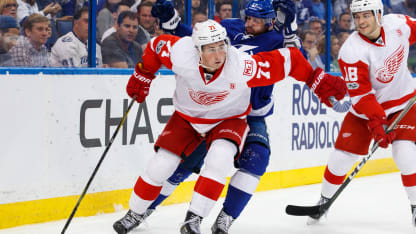Larkin feels ready for full-time center role with Red Wings
Promising rookie season on wing was followed by difficult transition in 2016-17

© Scott Audette/Getty Images
That Larkin pictures himself as the Red Wings' No. 3 center behind Zetterberg and Nielsen isn't all that surprising considering he regressed in his second NHL season and has about 30 games of experience playing in the middle in the League.
But that Larkin, who has played on the wing at least 75 percent of the time in his first two NHL seasons, targets himself as a center is a significant step in his development. It shows he's a step closer to becoming what Red Wings coach Jeff Blashill feels he can be: a 60-plus-point, 200-foot, top-line center, much in the way Jonathan Toews is for the Chicago Blackhawks and Zetterberg has long been for the Red Wings.
RELATED: [31 in 31: Inside look at Detroit Red Wings | Top prospects for Detroit Red Wings]
"His best attributes are utilized when he plays center," Blashill said. "I think he can continue to grow into becoming a great two-way center who can create offense and is very accountable defensively. And I think his defensive instincts are served at center, where he can anticipate where the puck is going, meet the puck and get out of the zone as fast as possible."
Larkin's production dipped last season from his successful rookie season. He played 80 games, just as he did as a rookie, but he had 17 goals, down from 23, and 32 points, down from 45. He was minus-28 after finishing his rookie season plus-11.
Larkin, who attended the Power Edge Pro Camp with other NHL players (including Edmonton Oilers center Connor McDavid) earlier this month, started last season as a center with Zetterberg on his wing, but he was minus-5 with one assist through four games, so Blashill moved him back to the wing. He stayed there until February, when it was getting clear the Red Wings were not going to make the Stanley Cup Playoffs.
Blashill moved him back to center at that point with an eye on this season.
"I went into last [season] saying I need to make sure that I help Dylan become the very best player he can be, and in doing so, when he made mistakes, there was an accountability factor, which helps a player grow but is hard during the stretch when you're going through it," Blashill said. "I've had that happen with multiple players on this team, but that's always been in Grand Rapids [when I was the coach there]. Dylan had to do it in front of everybody in Detroit."
The hope is that it was worth it. Larkin and Blashill are optimistic it was because they feel what Larkin lacked in production and plus/minus he made up for in growth as a center, in figuring out the importance of playing a 200-foot game, in discovering how to use his creativity and his linemates and in realizing he has defensive instincts and can use them too.
Blashill said he saw signs of Larkin coming of age when he coached him in the 2017 IIHF World Championship after last season. Larkin was second on the United States with 10 points (two goals, eight assists) in eight games.
"What happens when a coach is pointing out a lot of mistakes or you might be sitting out shifts because of mistakes is you lose your confidence. It's just part of the process of developing, it really is," Blashill said. "I think as last season went along, he learned to play that complete game that is going to make him successful and he regained his confidence. I really saw that at the World Championship, so I expect Dylan to hit the ground running this year."
Larkin expects that of himself too. He said he grew comfortable with his role in the middle of the ice late last season because he played there regularly, watched a lot of film, and especially watched Zetterberg closely.
"I'm watching to see if he's going to change," Larkin said. "He doesn't change."
Larkin began to understand where he needed to be on the ice, how he could get the puck, get it in the hands of his linemates and get it back. He said he started to adjust in the faceoff circle too, largely because he was there more often.
Larkin won 46.2 percent of his 212 faceoffs in his final 30 games (7.06 per game) after winning 44.5 percent of 220 in his first 50 (4.4 per game).
"I think one of the hardest things to do for young players is to learn how to be offensive within the system and to play winning hockey," Blashill said. "What's winning hockey? Winning hockey is making sure you manage your risk, that you don't take unneeded risk, that you manage that risk-reward.
"We have great examples of guys that have done that here in Detroit and I think he learned over the course of the season how to do that, how to create offense but still be accountable defensively. It's a hard lesson to learn. He learned it. As that happened his natural ability, creativity and instincts started to take hold. He realizes being the 200-foot player ultimately allows him more offense."
Larkin said he wants to score at least 20 goals and 55 points and be a plus player this season.
"And our team is in the playoffs," Larkin said. "That's a good year for me."
A better season would be to do all that while playing himself into the top-six forward group, pushing Zetterberg to the wing. That would be another step in his development, another stride he takes into becoming the top-line center the Red Wings think he can be.

















